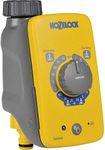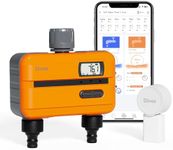Buying Guide for the Best Water Timers
Choosing the right water timer can make a significant difference in maintaining a healthy garden or lawn while saving time and water. A water timer automates the watering process, ensuring your plants get the right amount of water at the right time. When selecting a water timer, it's essential to consider various specifications to find the best fit for your needs. Here are some key specs to look out for and how to navigate them.Number of ZonesThe number of zones a water timer can control refers to how many separate areas or irrigation lines it can manage. This is important because different plants or garden sections may have varying watering needs. Water timers typically range from single-zone models to those that can handle multiple zones. If you have a small garden or a single type of plant, a single-zone timer may suffice. However, for larger gardens with diverse plant types, a multi-zone timer allows you to customize watering schedules for each area.
Programming FlexibilityProgramming flexibility refers to how customizable the watering schedules are on the timer. This includes the ability to set different start times, durations, and frequencies for watering. High flexibility is crucial for tailoring the watering schedule to the specific needs of your plants and the local climate. Basic timers may offer limited options, such as daily or weekly schedules, while advanced models allow for more detailed programming, including multiple start times per day and specific days of the week. Consider your garden's requirements and how much control you need over the watering schedule.
Watering DurationWatering duration is the length of time the timer will keep the water running during each cycle. This is important because different plants and soil types require varying amounts of water. Timers typically allow you to set durations ranging from a few minutes to several hours. For example, lawns may need longer watering sessions, while flower beds might require shorter, more frequent watering. Assess the needs of your plants and choose a timer that offers suitable duration settings.
Power SourceWater timers can be powered by batteries, solar energy, or a direct electrical connection. The power source is important for ensuring the timer operates reliably and suits your setup. Battery-powered timers are easy to install and portable but require regular battery changes. Solar-powered timers are eco-friendly and reduce maintenance but need sufficient sunlight to function. Electrically powered timers offer consistent performance but require a nearby power outlet. Consider the convenience and practicality of each power source for your garden.
Weather ResistanceWeather resistance refers to the timer's ability to withstand various weather conditions, such as rain, sun, and temperature fluctuations. This is crucial for ensuring the timer's durability and longevity. Look for timers with a high IP (Ingress Protection) rating, which indicates good protection against dust and water. If your timer will be exposed to the elements, choose a model designed to handle outdoor conditions to avoid frequent replacements or malfunctions.
Ease of UseEase of use encompasses how simple it is to set up and operate the water timer. This is important for ensuring you can quickly and effectively manage your watering schedule without frustration. Timers with intuitive interfaces, clear displays, and straightforward programming are generally easier to use. Some models also offer smartphone connectivity for remote control. Consider your comfort level with technology and choose a timer that matches your preference for simplicity or advanced features.












![HOZELOCK - Manual Countdown Timer for Watering: Mechanical Switch, Compatible with Ø 21mm (1/2"), Ø 26.5mm (3/4") or Ø 33.3mm (1") Water Taps, Watering Duration 5 to 120 Min, Easy Connection [2210]](https://images-proxy.bestreviews.guide/LF6qBjxbvSQnFhLBrNC03ESTd2c=/0x150/https://m.media-amazon.com/images/I/416LuVziZiL._AC_CX679_.jpg)


